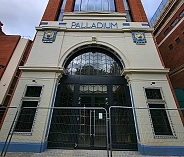Adam Yamey's Blog: YAMEY, page 118
July 30, 2022
Piero della Francesca in my life
A FEW WEEKS AGO, we were going to meet friends at a Chinese restaurant in London’s Chinatown. As we had arrived in the area far too early for our rendezvous, we decided to pass some time looking at pictures in the nearby National Gallery. We headed for the rooms containing paintings from the Renaissance era, which we had not visited for a long time because usually, for reasons that I cannot fully explain, we look at works created in later periods. We entered one of the rooms and I stopped in front of a couple of paintings that brought childhood memories flooding into the forefront of my mind. Both artworks are lovely creations of the early Renaissance painter Piero della Francesca (‘Piero’; c1415-1492).
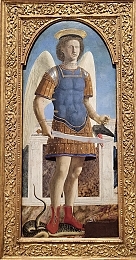 In the National Gallery, London
In the National Gallery, LondonIn my childhood and early adulthood, I lived at 36 Hampstead Way in Hampstead Garden Suburb. The front door was under a covered porch and reached up a few stairs that led up from the street. The front door opened into a hallway with red polished stone flooring and a few pictures hanging on its walls. At the end of the hallway, facing the front door, there was a large high-quality photographic reproduction of the “Montefeltro Altarpiece”, painted by Piero. This coloured picture had been bought in Florence (Italy) from Alinari, the famous photography company that specialised in taking good photographs of artworks. The feature of the picture that always fascinated me was the egg suspended from a scallop shell above the head of the Madonna. I have learned recently that the egg depicted is an ostrich egg, symbol of the new Venus: i.e., the Virgin Mary. It has also been suggested that it is not an egg but a pearl, which is a reference to the Immaculate Conception (pearls are created in oyster shells without sexual intervention!).
Also in the hall, there was a smaller coloured reproduction of another of Piero’s paintings: “The Flagellation of Christ”. Mounted on board and glazed with a shiny varnish, this reproduction was smaller than the original. So, every time I entered or left our home, I used to see these two images originally created by Piero. They were a part of my life.
My parents loved Italy. We visited Florence and Venice every year except 1967, the year after Florence had suffered from a devastating flood. My mother was a sculptor, and my father was a serious amateur art historian with a special interest in the Italian Renaissance. Hence, their love of Florence and the art treasures it contains. Piero was amongst their favourite artists.
Piero was born in Borgo Santo Sepolcro (‘Sansepolcro’) in Tuscany, which is about 47 miles southeast of Florence. Once when we were staying in Florence, we made an excursion to Arezzo, where there are some frescos by Piero, and then to Sansepolcro. There, we visited the Museo Civico that contains one of Piero’s great works: “The Resurrection”. None of us, my parents, myself and my sister, had seen it ‘in the flesh’ before.
For my father, Piero was not the only reason for our visit to Sansepolcro. In addition to his deep interest in the history of art, Dad was one of the world experts in the history of … wait for it … double-entry bookkeeping. This system of accounting has been a cornerstone of business since it was invented by the mathematician Luca Pacioli (c1447-1517), whose life overlapped that of Piero. Not only that, but Luca was also born in Sansepolcro. Apart from his advances in accounting methods, Luca also wrote various mathematical treatises including “Summa de arithmetica, geometria. Proportioni et proportionalita”. The second volume of this was Luca’s rewriting of a work by Piero. And the third volume was an Italian translation of “De quinque corporibus regularibus”, which had originally been written by Piero. Apparently, in both cases Luca made no mention of Piero as their author.
Although Piero and Luca figured often during the years I lived with my parents, I have not thought about either of them for a long time. It was only when we entered the National Gallery to pass time whilst we waited for our friends that seeing the paintings by Piero evoked childhood memories.
July 29, 2022
Once it crossed the River Mersey, but now it has gone
WIDNES IN CHESHIRE is across the River Mersey from the town of Runcorn. In the past, both places were important industrial centres. Currently, they are linked by two impressive road bridges (the Mersey Gateway, opened in 2017; and the Silver Jubilee Bridge, opened in 1961 and given its present name in 1977) and a Victorian railway viaduct. The Silver Jubilee Bridge (‘SJB’) begins cross in the Mersey from Widnes near to St Mary’s church and the Victoria Gardens.
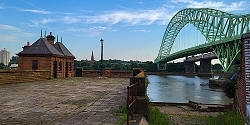
A few feet downstream from the SJB, there is what looks like a short jetty projecting a little way over the Mersey. On one side of this, there a small building with two separate slate roofs. The wide jetty-like structure looks disused. And so, it is. The structure is all that remains on the Widnes riverbank of the Widnes–Runcorn Transporter Bridge. Until 1905, when it was constructed, the only bridge across the Mersey at Widnes was the railway bridge (variously named as The Runcorn Railway Bridge, Ethelfleda Bridge, and Britannia Bridge), which was opened in 1868.
Between 1901 and 1905, when it was opened, the transporter bridge was under construction. It was the first of its kind in Britain. At each end of the bridge there was a 180 feet high steel tower. Suspended from them and spanning the length between them was a 1000-foot-long girder along which ran a continuous loop of cable. A transporter car was attached to the cable. The loop of cable was wound around a wheel attached to a winch on an engine housed in a building: the one which can be seen on the jetty-like structure at Widnes. As the wheel rotated, the cable moved, and the car attached to it moved across the river and high above it. The crossing took about 2 ½ minutes in favourable weather.
When it was built, the transporter bridge was cheaper to construct than a conventional bridge such as the one that replaced it in 1961 (i.e., the SJB). The transporter bridge, which was deemed inadequate for modern traffic volumes, was closed on the day that the SJB was opened, and it was demolished soon after. All that remains in Widnes is what can be seen at the end of Mersey Road next to the start of the SJB and Victoria Gardens. Although we did not visit Runcorn, I have read that the approach to the transporter bridge can be seen on that side of the river.
When we came across the remains of the transporter bridge, we had no idea what we were looking at. We asked several young people nearby, and they were unsure of its purpose. Older people whom we met in the nearby friendly pub (The Mersey), whose garden provides not only a pleasant place to drink but also a fine view of the SJB and the railway viaduct, were able to inform us about the bridge which is no more.
July 28, 2022
A Boer War warrior in Warrington
PALMYRA SQUARE IS a delightful rectangular piazza in the heart of Warrington in Cheshire. I use the word ‘piazza’ because the English word ‘square’ includes many squares which are anything but square. The centre of this open space is filled with the pleasant Queen’s Gardens, the Queen in the name being Victoria. It was near the end of her reign that the 2nd Anglo-Boer War (‘Boer War’; 1899-1902), a bloody conflict between the British Empire and the Dutch speaking colonists in what is now South Africa, occurred. In the middle of the eastern half of Palmyra Square there is the statue of a man in a helmet carrying a rifle in his left hand. His right arm points forward, as does his right index finger. The other fingers of his right hand clutch a pair of binoculars. He is wearing knee high boots, standing on a sculpture of a rock, and dressed in an old-fashioned military uniform. As soon as I saw this statue, I guessed (from the style of the uniform) it was connected the Boer War, and when I looked at the plinth upon which the military figure is perched, I discovered that I was right.
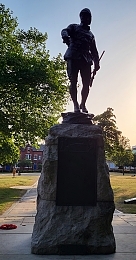
The monument was unveiled by General Sir Redvers Henry Buller (1839-1908), in the year before his death. Buller commanded British forces in South Africa during the Boer War. The man depicted on the plinth is Lieutenant Colonel MacCarthy O’Leary (1849-1900). He was killed on the 27th of February 1900 whilst leading men of his regiment (The South Lancashire) during the Battle of Pieters Hill. Richard Danes in his “Cassell’s History of the Boer War” (published 1901) pointed out that the 27th of February was Majuba Day, which was when the British were soundly beaten by the Boers at the Battle of Majuba Hill in 1881. The battle at Pieters Hill, which led to a British victory, facilitated the opening of the road to Ladysmith, which was being besieged by the Boer forces. An informative website (www.alamy.com/stock-photo-statue-of-l...) revealed:
“The Regiment drew many of its recruits from the then-South Lancashire town of Warrington, where Colonel O’Leary was very well known. When the town erected a memorial to the men of the Regiment who died during the war, it chose to feature a sculpture of Colonel O’Leary on campaign in South Africa.”
The statue was sculpted by Edward Alfred Briscoe Drury (1856-1944). Amongst his many other creations is the South Africa Gate on The Mall in London.
The plinth upon which O’Leary stands forever motionless bears a large plaque on which the many members of the 1st and 2nd Battalions of the South Lancashire Regiment, who died during the Boer War, are recorded. These include a few officers and too many men of lower rank. Another plaque records the campaigns in which the regiment was involved. Apart from Pieters Hill, these were: Spion Kop, Vaal Krantz, Colenso Kopjes, Tugela Heights, Relief of Ladysmith, Botha’s Pass, Laings Nek; and the occupations of Wakkerstroom, Utrecht, and Vryheid. In other words, they took part in most of the important struggles during the Boer War.
The monument stands in a peaceful square in a small town, once in Lancashire but now in Cheshire, just about 400 yards from the River Mersey. As I stood looking at it during an unusual heatwave when the air temperature was between 35 and 37 degrees Celsius, I wondered how the brave men recorded on the plinth, who would have been encumbered with military equipment and inappropriate uniforms, managed to keep on going during the hot weather that they would have encountered whilst struggling against the Boers in the south of Africa.
July 27, 2022
Palladium
July 26, 2022
The road to Wigan Pier and …
WIGAN PIER WAS made famous by the author George Orwell, who published his “The Road to Wigan Pier” in 1936. Recently, we were staying in Widnes (Cheshire), which is not far from Wigan, a town that was in Lancashire when Orwell wrote his book. So, we decided to see Wigan Pier for ourselves.
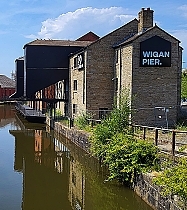
A quick glance at a map reveals that Wigan is not on the sea, which is where most piers are to be found. The town is inland, and the so-called Wigan Pier is neither a pier nor on the seaside. It is on a part of the Leeds and Liverpool Canal in central Wigan. It was originally a landing stage where locally mined coal was loaded onto barges.
The name ‘Wigan Pier’ might have originated when a train carrying excursioners to the seaside was delayed at Wigan and they saw a structure that looked like a pier, as the following (from http://www.wiganarchsoc.co.uk/content/Projects/WiganPier.htm#Folklore ) described:
“…not long after leaving Wallgate Station, an excursion train from Wigan to Southport, was delayed on the outskirts of Wigan and passengers saw a long wooden structure that reminded them of Southport Pier. This structure would have been the 1,050 yard long wooden gantry … It was built in the late 1880s and carried a double line of rails from Lamb and Moore’s Newtown Colliery high across the River Douglas, the canal and the Wigan to Southport Railway line, to Meadows Colliery by Frog Lane … It certainly would have been easy to see this wooden gantry from a train heading towards Southport.”
I cannot say whether or not this is the true origin of the name, but it is a good story.
We took a road to Wigan Pier and after going around the town’s one-way system and several roundabouts, passing a huge Asda store a couple of times, we arrived at a series of old warehouses labelled Wigan Pier, and parked next to the canal. The Orwell visitor centre, which we were led to believe existed, is no more. A passer-by, with whom we chatted, told us that any memorials to Orwell and his book had disappeared a few years ago. Likewise, the collieries: these have been closed down long ago. Where they were there are housing estates, factories, and shops.
The warehouses close to where the coal used to be loaded many years ago, were inaccessible. They are being redeveloped to create a leisure ‘hub’. This will include (according to hoardings surrounding the old buildings): a beer tap house; conferences; live music; canal tours; festivals; a food hall; and an ‘artisan deli’. I am not sure what is meant by an artisan deli, but whatever it is, I am sure that should George Orwell ever make his way back along the road to Wigan Pier, he would be truly astonished by it.
July 25, 2022
The golden gates
BANK HALL IN Warrington (Cheshire) was designed for the local industrialist Thomas Patten (1690-1772), who had successful copper processing works, and built in 1750. It was designed by James Gibbs (1682-1754), whose other creations include St Martin-in-the-Fields (London), Radcliffe Camera (Oxford), and the Senate House (Cambridge), to mention only a few. This elegant building with neo-classical features has served as Warrington’s Town Hall since about 1870. Impressive as the building is, its magnificence pales when it is compared to the grand gates at the entrance to its grounds.
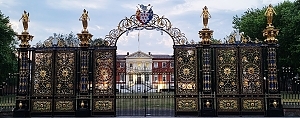
Frederick Monks, a local ironmonger and town councillor, heard about a pair of wonderful cast-iron gates which had been made at the Coalbrookdale works at Ironbridge in Shropshire. The gates had been made to be exhibited at the International Exhibition held in South Kensington in 1862. The gates were intended for Queen Victoria’s residence at Sandringham (Norfolk). However, when she saw them at the exhibition, she noticed a statue of the regicide Oliver Cromwell behind them. This put her off the idea of installing them at Sandringham.
The gates, having been rejected by Victoria, were offered for sale by the company that had made them. Eventually, Frederick Monks purchased both the gates and the statue of Cromwell for his town, Warrington. The gates were installed in front of the Town Hall in the late 1890s. An informative website (www.warrington.gov.uk/history-golden-...) describes features of the gates, which were recently restored beautifully:
“Because the owner was supposed to be Queen Victoria, the gates have four winged figures of Nike, the goddess of victory. They also had a Prince of Wales motif above the arch in the middle, but this was changed to Warrington’s Coat of Arms.” We had no idea that these gates with gold gilding existed. So, when we came across them during a post-prandial stroll, we were both surprised and delighted. When you see these beautiful gates, you can understand why Warrington is so lucky to have them. Incidentally, the bronze statue of Cromwell is also in the town: on Bridge Street. Before it was erected there in 1899, there was much discussion in the town council about the suitability of celebrating the regicide with the statue.
July 24, 2022
Breakfast at Shellys in Cheshire
“BREAKFAST LIKE A KING; lunch like a prince; dinner like a pauper”. This popular saying emphasizes the importance of breakfast amongst the meals partaken during the 24 hours of a day. We spent three nights in Widnes (Cheshire) in July (2022), and wanted to enjoy a decent breakfast. A search of Google revealed that the best-rated place for breakfast was Shelly’s Café located close to Harrison Street, a small road leading off the larger Hale Road.
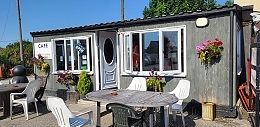 Shelleys café
Shelleys caféThere is a sign (for Shellys) with an arrow at the corner of Harrison Street and an unnamed short road with a badly damaged surface. This side road, which is lined on one side by dust-covered parked vehicles, some with flat tyres, leads to a pair of large metal gates, which were closed when we arrived. A key-pad next to the gates allows one to ring Shelley’s. When answered, the gates open slowly. We drove through them into a secure industrial area. This contains several buildings, some of which are warehouses and others factories (including several ice-cream manufacturers). In between the buildings, there are numerous parked cars, vans, and caravans. Most of them are old models covered with a thick layer of dust. We learned that some of them have been standing unused for a year or longer.
Shellys Café is housed in a single-storey wooden shack, adorned with pots of flowers, next to the electrically operated entrance gates. It has large windows and there were chairs and tables outside. The interior is simply decorated with a few wall plaques relating to the joys of riding motorcycles. Two large blackboards list what is on offer. One corner of the building is occupied by a spacious kitchen where Shelley and her husband prepare customers’ orders. On each of the three mornings we ate at Shellys, we sat beneath a photograph of Marilyn Monroe. The café had other framed photographs of film stars.
Everything we ordered was delicious. The fried items (including eggs, bacon, black pudding, mushrooms, sausages, hash browns, and tomatoes) were tasty and totally free of grease. What is on offer at Shellys is basic and unpretentious, but well-prepared. Given that this place is rated the best for breakfast in the Widnes area, it is remarkably good value. Were it nearer our home in London, I am sure that we would drive out to eat there, despite the industrial nature of its location.
July 23, 2022
Without shade when the temperature rises
 35 degrees Celsius at Arley Hall, Cheshire
35 degrees Celsius at Arley Hall, CheshireWhen the heatwave arrives
Common sense often departs
Heatstroke follows
July 22, 2022
Alice through the stained glass windows
CHARLES LUTWIDGE DODGSON (1832-1898), better known as Lewis Carroll, author of “Alice’s Adventures in Wonderland”, was born in the village of Daresbury in Cheshire. During his first few years of life, Charles’s father was the curate of the local church of All Saints.
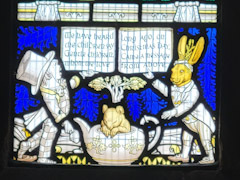
When he was 11, the Dodgson family moved away from Daresbury. Eventually, Charles entered Christ Church College in Oxford. It was here that he met the young child Alice Liddell, daughter of the Dean of Christ Church. It was this young child who inspired Dodgson to create and later publish his famous story. Unlike many other Victorian tales for children it was free from moral instructions.
Dodgson/Carroll died in Guildford, where he was buried. To celebrate the 100th anniversary of his birth, money was raised to create a window in the church in Daresbury to commemorate him. Known as the Lewis Carroll Window, it allows light into a Chapel in the southeast corner of the church. Designed by Geoffrey Webb, it was dedicated in mid 1935.
The stained window incorporates depictions of both Carroll and Alice Liddell, as well as some of the creatures drawn originally by John Tenniel, who illustrated the book about Alice.
A modern addition to the church was built onto its North side. This contains a Lewis Carroll exhibition. One of the exhibits is an old Bell. This used to be attached to a barge that served the religious needs of the people who lived and worked on the canals near Daresbury. This floating chapel was the creation of Lewis Carroll’s father.
We visited Daresbury on a July day when the air temperature was 37 degrees Celsius. Fortunately, it was cooler inside the church. I am grateful to Christine Casson for encouraging us to visit the church with the Wonderland window.
July 21, 2022
Great expectations
I LOVE OUTDOOR sculpture exhibitions. Also, I enjoy visiting the exhibition spaces of the White Cube Gallery, which are located in Piccadilly and Bermondsey. So, it was with high expectations that we drove up to Arley Hall in Cheshire to view an exhibition of outdoor sculpture by artists with whom the White Cube represents.
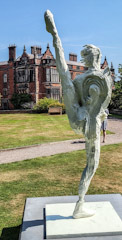
The works on display until the 29th of August 2022 are by artists including amongst others Gormley, Noguchi, Tracey Emin, Mona Hatoum,and Takis. This is a formidable line up of artists.
Arley Hall and its gardens are magnificent. Unfortunately, the same cannot be said of the temporary exhibition of works by eminent modern sculptors. Unlike other outdoor sculpture shows I have seen (e.g. Frieze at Regents Park, Houghton Hall, and the Yorkshire Sculpture Park), what was on display in Arley Hall’s garden was unexciting despite the delightful setting. I felt that White Cube, whose exhibitions are, if nothing else, always dramatic, could have displayed a more impactful selection of artworks.
Exhibition aside,visiting the grounds of Arley Hall was well worthwhile as it has given us the opportunity to spend some time in Cheshire, which we do not know well.

